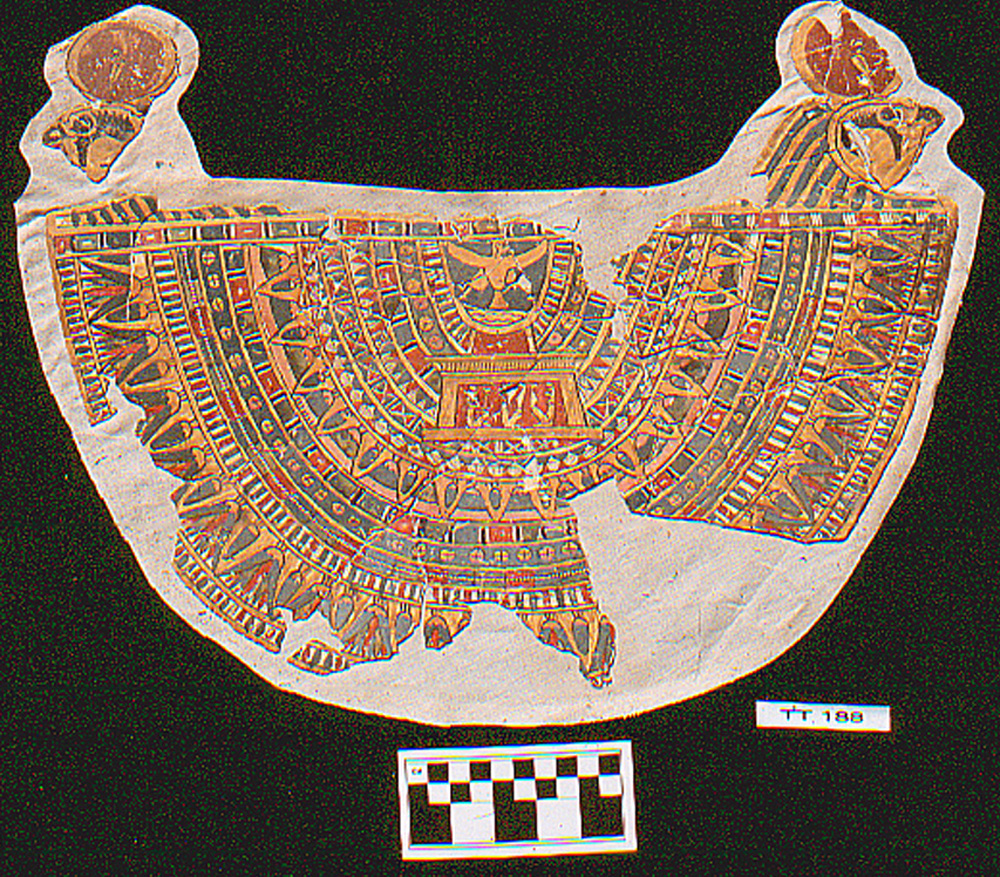Mummy's Colorful Collar Found in Egyptian Tomb

A collar with "almost pristine" colors that would have been worn by a mummy has been discovered in small pieces in an Egyptian tomb in Thebes and put back together again.
People in ancient Egypt wore collars called "wesekhs" made of beads when they were alive. This painted collar is made of a different type of material called cartonnage (a plastered material) and was meant to be worn by a mummy after death. A clay seal found near the collar suggests that it was worn by the mummy of a wealthy undertaker.
Dating back around 2,300 years ago and found in modern-day Luxor, the collar is painted in a vivid array of colors, designs and images that show elements of ancient Egyptian religion. The god Horus is signified by two falcons wearing red sun-disk crowns on the top corners, while at top center is a human-headed bird (called a "Ba" bird) that represents, in essence, the immortal soul of the deceased mummy. [In Photos: The Mummy of King Ramesses III]
Additionally, in the center of the design, there is a drawing of a golden shrine with two goddesses, possibly the sisters Isis and Nephthys, facing a deity in the center that may be the jackal-headed Anubis. The collar is about 8.7 inches (22 centimeters) high (not including the falcons) and about 16.5 inches (42 cm) in width. Near the bottom of the collar lotus blossoms are shown flourishing.
Complex tomb
The tomb that it was found in is a complex place. Originally it was built more than 3,300 years ago for a butler named Parennefer who served the pharaoh Akhenaten. Then, sometime later, an official named Amenemopet excavated his own tomb into part of the butler's courtyard. As the centuries went on more individuals (the precise number is unknown) were buried at the site, one of them being interred around 2,300 years ago with this colorful collar.
The re-use of tombs was a common practice in Thebes. "I guess it was much more economical to use these old derelict tombs than to excavate out new tombs at that time," Susan Redford, of Penn State University, told LiveScience in an interview. She and her team found hundreds of cartonnage fragments in excavations at the site, the fragments that made up this collar being discovered in 2000 and 2002. The team's artist, Rupert Nesbitt, carefully put the collar back together again, along with several other coverings that belong to different mummies.
Get the world’s most fascinating discoveries delivered straight to your inbox.
"These pieces could range from about palm-sized to dime-sized," Redford said. "It was like a giant jigsaw puzzle," added Redford, who detailed the collar discovery in a paper in "Archaeological Research in the Valley of the Kings & Ancient Thebes: Papers Presented in Honor of Richard H. Wilkinson" (University of Arizona Egyptian Expedition, 2013). [See Photos of Egypt's Valley of the Kings]
Archaeologists cannot say for sure whom this collar belonged to. In addition to being re-used multiple times the tomb site has been robbed in both ancient and modern times and, until recently, was even used to hold dead animals.
Egyptian tombs and temples tended to be very colorful places and the collar reflects that, Redford said.
An undertaker's collar?
The mummy who wore this collar is now gone or otherwise part of the various humans remains found in the tomb. However, an inscription written in a mud-clay seal was found near the fragments of the collar.
The seal would have held together the string or binding of a papyrus scroll. While the scroll itself is mostly destroyed, the inscription from the seal says that it is for a man named "Padihorwer," reading (in translation) that he was "privy to the mysteries and god's sealer, 'embalmer,' scribe, prophet of the 'desert' (necropolis) of Qus," which is located north of Thebes.
An ancient archival record also survives, telling of "a man of Qus" being buried at Thebes in the same period that the collar has been dated to, Redford said.
Padihorwer was basically an undertaker, a profession that could bring some level of wealth. "He's a little higher than just an ordinary necropolis worker," she said, noting that these ancient undertakers arranged for embalming and burial, were paid by families and generally ran their affairs like a business. "We think that they had a guild of sorts," she said, "it was a business just like undertakers are today."
If this collar, with its elaborate decorations, was worn by Padihorwer, it would suggest that his business prospered and that he was a relatively wealthy undertaker at the time he was buried.
Follow LiveScience @livescience, Facebook & Google+. Original article on LiveScience.

Owen Jarus is a regular contributor to Live Science who writes about archaeology and humans' past. He has also written for The Independent (UK), The Canadian Press (CP) and The Associated Press (AP), among others. Owen has a bachelor of arts degree from the University of Toronto and a journalism degree from Ryerson University.



